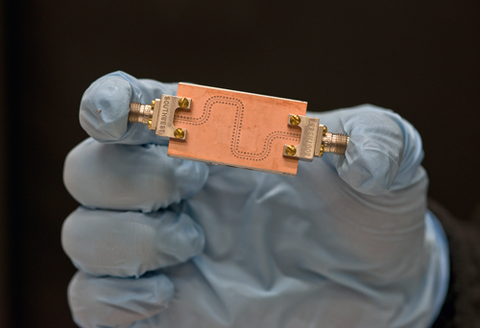
Coplanar wave guide, developed at NIST, used to apply microwave magnetic fields to multilayer films for ferromagnetic resonance measurements.
A highly sensitive measurement system for the performance of nanoscale magnetic devices, invented and developed at NIST, was successfully replicated recently by Intel Corporation, enhancing the company's ability to evaluate the tiny structures' suitability for use in future computing. Now scientists from Intel and Stanford University have published their first results from the NIST-model system in the Journal of Applied Physics.
"It's sort of the next stage in tech transfer," says Tom Silva of NIST's Physical Measurement Laboratory. "Not only are they using it, but they're publishing papers on measurements taken with it."
The system in question, called a ferromagnetic resonance (FMR) spectrometer, allows scientists to examine the dynamic properties of materials for potential eventual use in "spintronic"* random-access memory (RAM). That field is a matter of urgent interest worldwide because of spintronics' intrinsic high speed and low power requirements.
Conventional computer dynamic RAM works by storing binary data as charge states in arrays of minuscule capacitors. That requires an electrical current to perform memory operations, and then more current to continuously refresh the system so that the data will not be lost as the capacitors gradually discharge, a condition called volatility. (The current can produce a substantial amount of heat in chips with billions of individual components packed together on the nanometer scale.)
Spintronics, by contrast, processes information by manipulating the spin states of electrons, a procedure that can be accomplished with vanishingly small amounts of power in a very short time. Moreover, once the information is "written" – that is, after a population of spin-aligned electrons alters the magnetic orientation of nanoscale ferromagnetic materials – spintronic memory is non-volatile.
But the performance of spintronic memory depends critically on the degree to which the ferromagnetic nanostructure materials resist changing their spin orientation. That property, called damping, has traditionally been very difficult to characterize and understand the kinds of extremely thin magnetic films that are required for memory applications.
So starting in 2009, Silva and NIST colleague Hans Nembach designed, built, and iteratively improved a system that could measure damping properties and reveal how they vary with material composition, mode of excitation, and layer thicknesses.
A sample is placed in a magnetic field and exposed to microwaves that travel down a waveguide. When the microwaves interact with the material, the electron spins tend to resonate with the microwave frequency and the applied magnetic field; changes in resonance are monitored as the magnetic field is varied. Adjusting the parameters of the system identifies key parameters in the material's damping properties.
With collaborators including NIST's Justin Shaw, the scientists published the initial results from the system in 2011. "Hans Nembach and I basically beat on the instrument and figured out all the ways we could get rid of the noise sources for measuring very challenging, single-layer samples," Silva says. "We modified it to eliminate most of the noise, and pushed the sensitivity up to where we can measure films in the range of 0.5 nanometers or so."
Shortly thereafter, Brian Doyle from the Components Research Department of Intel in Hillsboro, Ore., came to the Silva/Nembach lab and expressed interest in the FMR spectrometer.
"There are a plethora of logic and memory devices being researched at present. One of our jobs in Components Research is to sort through the various devices and establish the real from the hype," Doyle says. "For that, having the possibility of being able to nail down the key physical properties of any given system is fundamental to being able to accurately benchmark new devices.
"For spintronics devices, the reputation and expertise of Silva and co-workers in both magnetics and magnetic measurements made this a natural place to visit and to collaborate with, taking advantage of the unique role NIST plays in its interactions with industry."
Eventually, Intel decided that it needed its own instrument based on the NIST design, and Silva and Nembach advised the company about how to replicate their system.
"World-known experts in magnetic dynamics Tom Silva, Hans Nembach, and Justin Shaw have been essential in advancing Intel's understanding of magnetic thin films," says Kevin O'Brien, a senior engineer also from Components Research at Intel and one of the lead authors on the new publication. "Furthermore, we decided to reproduce the NIST FMR setup in-house at Intel because of the great data quality – essentially a copy exactly of the NIST experimental setup. We very much appreciate all of the support we have gotten from the NIST team."
* Just as electronics involves the manipulation of electron charges, spintronics generally involves the manipulation of an electron's "spin" – a kind of angular momentum that gives each electron a property analogous to a north or south magnetic polarity. If a number of electrons with aligned spins are transferred into a ferromagnetic material, it changes the net magnetization of the material. That change can serve as a unit of stored information.

